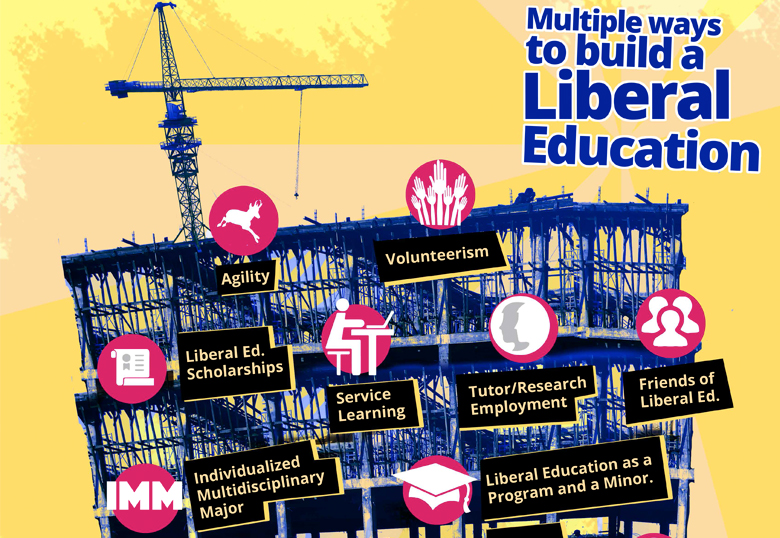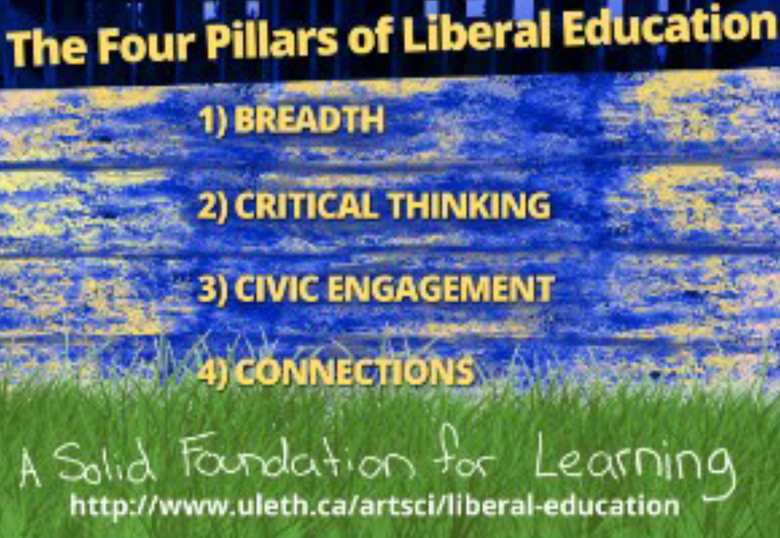The University of Lethbridge was founded on the principle of liberal education and nearly 50 years later, the principle remains just as central. Given the complexity of issues facing the world today, the ability to think critically, to innovate and to solve problems — skills learned while pursuing a liberal education — are perhaps even more valuable than they were when the University first opened its doors.

In his 2012 Fiat Lux Address, Dr. Andy Hakin, provost and vice-president academic, encouraged the University community to rethink liberal education to ensure it retained a primary role in a student’s post-secondary education. That signalled the start of a review and the formation of the Liberal Education Revitalization Team, consisting of faculty members Jan Newberry, Shelly Wismath, Shelley Scott and Bryan Kolb, along with Heather Mirau from the Provost’s office. Since then, the team has expanded to include faculty members Craig Cooper, Bruce MacKay, Nancy Grigg, Jean Harrowing, Dan Kazakoff, Nicole Eva, along with Tiffany Herrell and Brenna Scott.
“We spent a large part of the first year talking to everyone we could think of, faculty, staff, support staff, administrators, deans, students, advisors and alumni, and doing focus groups,” says Wismath.
The team found that the understanding of the term ‘liberal education’ varied from having no understanding to having a somewhat limited understanding. To some, liberal education was the same as the General Liberal Education Requirements (GLER), which require students to take courses in the sciences, social sciences, fine arts and humanities.
“We started as a liberal education university back in ’67 and we’ve always said that that’s what we are, but as we became bigger and shifted to comprehensive status, we kind of lost some of that,” she says.
The team developed a definition of liberal education that includes four pillars — breadth across disciplines, integration of knowledge across disciplines, critical thinking, and education for citizenship.
“We’ve really been promoting this for the last few years,” she says. “What’s been amazing is everyone has been very receptive. They agree that we provide a liberal education and that we should be making it clearer to our students and to our community.”
The team’s goals were to bring liberal education back into the forefront of people’s minds and help them understand how pervasive it is and how necessary.
“What we’re teaching, with critical thinking especially, are meta-level skills or 21st century skills. To me, the bottom line is that you learn how to learn at university. And that’s what employers really want, not that you know how to do exactly what they need you to do,” she says. “It’s also important to give students that language so, when they’re looking for jobs, that’s their edge, that they’ve had this kind of education. But if we don’t tell them about it, clearly then they don’t even realize that that’s what they have to offer.”

In addition to increasing awareness of liberal education, the project has effected changes to GLER courses. The team established the Liberal Education List and expanded it to include other Faculties in addition to arts and science and fine arts. So far, 21 courses from health sciences and management have been approved for the Liberal Education List.
“Up until now, LibEd was actually housed as a program in arts and science,” says Wismath. “Now that things have opened up to include all the faculties, we want to make this model of LibEd widespread on campus. One of the next stages is going to be to look for a sustainable and comprehensive organizational structure for liberal education.”
The revitalization team is also working with University recruiters to hone the liberal education message when they talk to high school students and encouraging faculty, especially those who are teaching first-year classes, to note liberal education in their course outlines. That helps ensure students become aware of liberal education early in their post-secondary lives and understand how their courses are connected to a bigger picture.
“We’re trying to promote Liberal Education now as a prevalent theme through all the undergrad teaching we do. We’re not asking people to change what they teach or how they teach, but just to keep those pillars and those skills or outcomes in mind and to point out regularly to students that they are getting a liberal education, and why that’s important, and to name the skills they’re developing,” says Wismath.
Focus groups so far have shown that students are very receptive to this message, especially as they move through their degrees. As one student said, “Not only do I have a better understanding of what Liberal Education is, I appreciate it much more and agree with what it tries to accomplish.”
